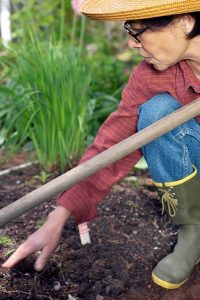Fall is the time to plant bulbs for early spring displays
October 21, 2016
The most important part of fall bulb planting is proper depth. As a rule of thumb, plant the bulb two to three times as deep as it is wide. (Photo courtesy of University of Illinois Extension)
Start next year’s flower display this fall.
Rhonda Ferree, horticulture educator with University of Illinois Extension, says that now is the time to set out the spring flowering bulbs. It seems like a lot of work now, but after the long winter you will really enjoy those blooms.
In addition to the standards such as tulips and daffodils, try some of the other small flowering bulbs. For example, anemones, snowdrops, and winter aconite all bloom very early and have especially beautiful flowers.
Snowdrops are among the smallest and daintiest of the spring-flowering bulbs and often flower in early March, before all the snow has gone.
Bulbs can be planted in perennial borders, rock gardens, or naturalized in the lawn and wild flower garden. They are grown for beauty, fragrance, cut flower use, or combinations of these. The informal growth of plants such as daffodils adapts well to naturalized plantings, but also does well in small groupings or foundation plantings.
Tulips, on the other hand, are very formal and look best when planted in clumps or beds of one color. Hyacinths are so stately that a few plants carefully placed will provide colorful spring interest and fragrance.
Ferree says to buy your bulbs early while the selection is good. The ideal planting time is about four weeks before the ground freezes. This allows the bulb to grow some roots before winter. Select bulbs that are firm and free from soft or rotting spots or other signs of disease.
Bulbs do best in well-drained soil. If your soil has a high clay content, the drainage can be improved by adding composts, peat moss, or other organic material.
To encourage root development this fall, many gardeners add phosphorus at planting time. The most common way to do this is to sprinkle a teaspoon of bonemeal in the bottom of each hole, cover it with a little soil, and then place the bulb.
You can also fertilize the shoots as soon as they break through the soil in the spring. Do not fertilize bulbs after they have started flowering.
According to Ferree, the most important part of bulb planting is proper depth. As a rule of thumb, plant the bulb two to three times as deep as it is wide.
Large bulbs such as tulips and daffodils will be planted about 8 inches deep and smaller bulbs like crocus will be planted 3 to 4 inches deep. Measure planting depth from the bottom of the bulb.
Bulbs should be planted with the nose of the bulb upward and the basal or root plate down. Special tools such as bulb augurs for the drill and hand diggers are available. Use these if they work better for you, but many prefer to simply dig individual holes with a hand trowel.
On another note, now is also the time to bring in the tender flowering “bulbs” for winter storage. Tender flowering bulbs include dahlias, gladiolas, cannas, tuberous begonias, and caladiums. These plants require special care since freezing temperatures kill them, but can be stored for replanting next year.
For more information about bulbs, go to the University of Illinois Extension Bulbs and More website at http://extension.illinois.edu/bulbs.
Contact Rhonda Ferree, University of Illinois Extension, (309) 543-3308, ferreer@illinois.edu
— Fall is the time to plant bulbs for early spring displays —







